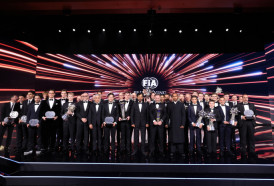Covering 21.0975 kilometers through the capital's Economic-Technological Development Area, the race redefined what it means to compete, innovate, and imagine the future of embodied intelligence.
Industry insiders highlighted the half marathon's balance of challenge and accessibility as it tested endurance while welcoming diverse participants.
The event saw humanoid robots line up alongside human athletes, launching from the same starting line but along physically divided lanes to ensure safety. While human runners followed conventional rules, robots competed under tailored guidelines.
Each robot was supported by a team of human navigators, operators, and engineers. Robots launched sequentially at intervals exceeding one meter, confined to dedicated tracks where battery swaps mirror Formula 1's pit stops. Awards were distributed not just for speed, but for categories like Best Endurance, Best Gait Design, and Most Innovative Form - celebrating both athletic performance and engineering ability.
Among 20 competing teams, Tiangong Ultra from the Tiangong Team claimed victory in the humanoid half marathon, crossing the finish line first with a time of two hours, 40 minutes, and 42 seconds. Standing approximately 1.8 meters tall and weighing 55 kilograms, Tiangong Ultra increased its speed from 6 km/h to a peak of 12 km/h and enhanced its intelligence this year using the Huisi Kaiwu platform, a universal embodied intelligence system. During the race, Tiangong Ultra maintained a steady pace of 7-8 km/h.
Yet beneath the novelty lay a formidable challenge. Robots had to navigate a demanding course that weaved through Nanhaizi Park, Paulownia Boulevard and Wenbo Bridge and confronted a gauntlet of terrains: cracked asphalt, gravel-strewn paths, undulating slopes, and grassy patches. Each surface demanded split-second adjustments in stride length, body posture, and power distribution, pushing locomotion algorithms to their limits.
Humanoid robots, composed of thousands of components, still face significant hurdles in achieving stable, long-distance running. "Real world conditions differ vastly from lab environments," explained Xiong Youjun, CEO of the Beijing Humanoid Robot Innovation Center.
To complete the race, robots require high-density integrated joints and bodies engineered for endurance and heat dissipation. They must also execute precise multi-joint coordination for running, navigation, and obstacle avoidance - a test of core algorithm development.
To mimic human motion, the team integrates human movement data to refine robotic gait. Structurally, they focus on weight reduction, leg coupling design, and advanced cooling systems to optimize endurance.
More than a race, this event served as a symbolic launchpad for China's burgeoning humanoid robotics industry.
In 2024, China's Ministry of Industry and Information Technology issued the Implementation Opinions on Promoting Innovation and Development of Future Industries, identifying fields such as smart manufacturing, household services, and operations in extreme environments as priority areas for humanoid robot deployment.
Data from China's Ministry of Industry and Information Technology reveals that as of July 2024, China holds over 190,000 valid patents related to robotics, accounting for approximately two-thirds of the global total.
Xu Xiaolan, President of the China Electronics Society, emphasized that emerging technologies like AI are in a phase of explosive innovation, with AI's role in empowering robotics growing increasingly prominent.
AzVision.az
















































